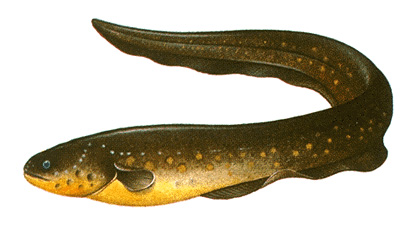Electric eel is a long, narrow fish that produces strong electric discharges, or shocks. Hundreds of fish species (kinds) can generate weak electric discharges of less than 1 volt. Electric eels can produce a discharge of up to 850 volts. Such a discharge can kill a fish and stun such potential predators as caimans (large reptiles) or humans. However, electric eels rarely harm people in the wild.


There are three known species of electric eels. They live in streams and rivers of tropical northern South America, in the Amazon and Orinoco river basins. They may grow to more than 7 feet (2.1 meters) long. Electric eels are olive-brown with a yellow or orange belly. Their long tail makes up about four-fifths of the total body length. They have two small fins on either side of the body behind the gills, and one long fin on the underside. Unlike most fish, they have no fins on the back or tail.
The electric eel’s electric current is generated by three pairs of electric organs. The largest pair runs along most of the length of the body. Each electric organ is made up of thousands of modified muscle cells called electroplaques or electrocytes. These coin-shaped cells are stacked in columns along the length of the body. Each electroplaque stores a small electrical charge. The charges of multiple electroplaques combine together to produce a stronger discharge. An individual electric eel generates powerful bursts of electric pulses, each pulse lasting about 1/500 of a second. These bursts are used to stun prey or to escape predators. The electric eel also generates a much weaker electric field in the water around its body that it uses to sense its surroundings, to detect prey, and to communicate with other electric eels.
Loading the player...Electric eel shocks a crocodile
Electric eels eat mostly smaller fish, but they may also eat amphibians, birds, and mammals. They sometimes gather in large groups to eat falling palm fruits. The male builds and guards bubble nests, where eggs and larvae (young) develop. A bubble nest is a type of nest created by some fish and frog species. It is made of bubbles and saliva. The male also guards young in his mouth for several weeks after hatching, during which time he does not feed.
